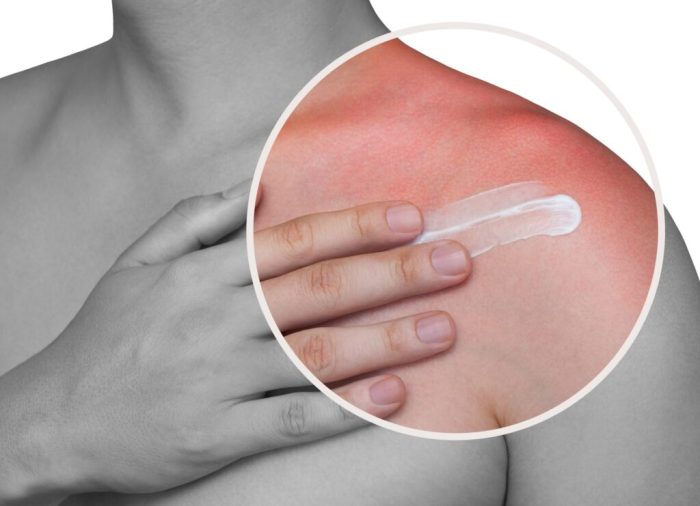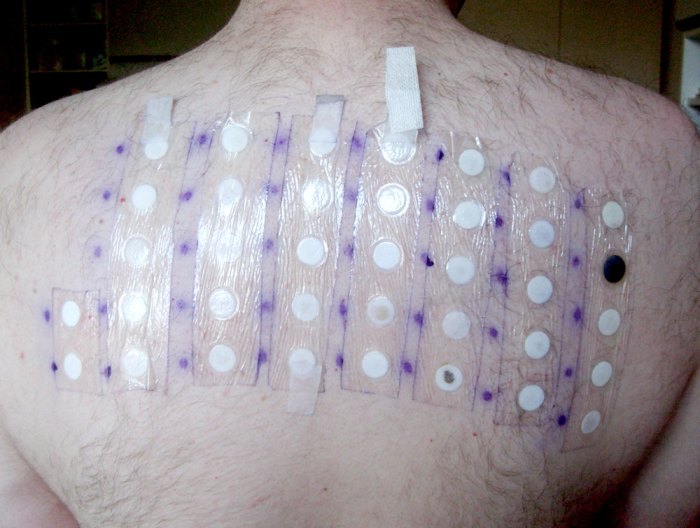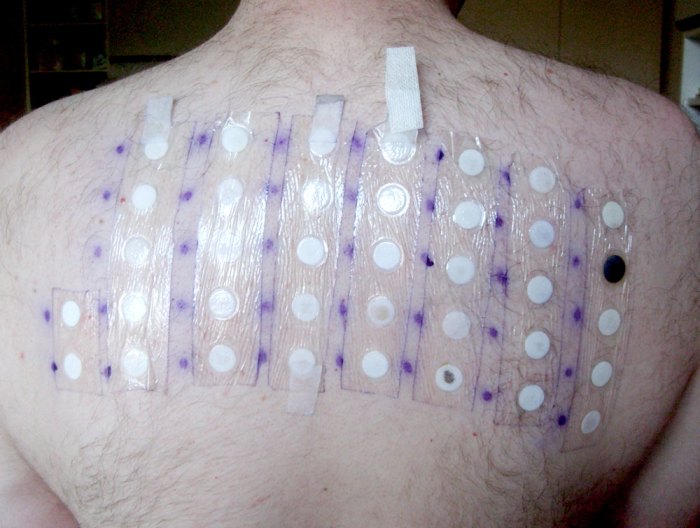Allergic to skin care products? You’re not alone. Millions experience skin reactions from seemingly innocuous lotions and creams. This in-depth exploration delves into the world of skin sensitivities, revealing the various types of reactions, common triggers, and effective management strategies. We’ll uncover the culprits lurking within your favorite skincare routines, equipping you with the knowledge to identify, treat, and prevent future problems.
From understanding the different types of skin reactions, like contact dermatitis and eczema, to identifying potential allergens within products, this guide provides a comprehensive approach to managing skincare sensitivities. We’ll explore ingredient lists, patch testing, and the importance of hypoallergenic products. Plus, we’ll address common concerns about preservatives, fragrances, and natural ingredients. Get ready to take control of your skin health!
Understanding Skin Reactions to Products

Skincare products, while meant to nourish and enhance our skin, can sometimes trigger adverse reactions. Understanding the different types of reactions, their triggers, and severity levels is crucial for choosing appropriate products and managing potential issues effectively. Knowing the potential culprits behind these reactions can empower you to take proactive steps to maintain healthy skin.Skin reactions to skincare products can range from mild discomfort to severe allergic responses.
Identifying the specific type and cause of the reaction allows for targeted solutions and prevents future issues. This understanding is key to achieving a skincare routine that respects your skin’s unique needs and sensitivities.
Types of Skin Reactions
Skin reactions to skincare products can manifest in various forms. Contact dermatitis, eczema, and hives are common responses, each with distinct characteristics.
- Contact Dermatitis: This inflammatory skin condition arises from direct skin contact with an irritant or allergen. It’s characterized by redness, itching, and sometimes blistering. The reaction typically appears within hours or days of exposure and often subsides once the offending product is removed.
- Eczema: Also known as atopic dermatitis, eczema is a chronic skin condition often marked by dry, itchy, and inflamed skin. Skincare products can exacerbate eczema, leading to flare-ups. Reactions can vary in appearance, from flaky patches to oozing sores.
- Hives (Urticaria): Characterized by raised, itchy welts on the skin, hives can result from various factors, including skincare products. These welts often appear in patches and can change shape and size over time. A severe reaction can also include swelling of the face, lips, or throat.
Common Triggers in Skincare Products
Numerous ingredients in skincare products can trigger adverse reactions. Understanding these triggers is essential for avoiding potential problems.
- Preservatives: Preservatives are crucial for preventing microbial growth in skincare products. However, certain preservatives, like parabens and formaldehyde-releasing agents, can be problematic for sensitive skin, causing allergic contact dermatitis or irritation.
- Fragrances: Fragrances are often added to products for their scent. However, fragrances can contain numerous chemical compounds that can act as allergens or irritants, leading to contact dermatitis or hives.
- Essential Oils: While often lauded for their therapeutic properties, essential oils can trigger allergic reactions in susceptible individuals. Certain oils, like citrus or cinnamon oils, are known for causing skin irritation or allergic contact dermatitis.
- Colorants: Colorants, although sometimes necessary for aesthetic purposes, can act as irritants or allergens. Some individuals react negatively to certain color additives.
- Other Ingredients: Many other ingredients in skincare products, including certain alcohols, emulsifiers, and humectants, can trigger allergic reactions or irritation in sensitive individuals.
Severity Spectrum of Skin Reactions
Skin reactions vary in severity, ranging from mild irritation to severe allergic reactions. Identifying the severity is essential for appropriate management.
- Mild Irritation: This involves redness, slight itching, and mild dryness. Symptoms often subside quickly after discontinuing the offending product.
- Moderate Irritation: Symptoms may include increased redness, more pronounced itching, and some scaling or dryness. The reaction may take longer to resolve.
- Severe Allergic Reactions: This can involve hives, swelling, difficulty breathing, or anaphylaxis. These reactions require immediate medical attention.
Comparing and Contrasting Symptoms
Different skin reactions exhibit varying symptoms, aiding in diagnosis.
Ugh, dealing with skin allergies from skincare products is a real drag. It’s like my skin is constantly protesting. I’ve been trying to figure out healthier ways to approach my skin routine, and I’ve been reading up on whether grapes might help with weight loss, since healthy eating is important. Turns out, some people claim grapes are great for helping maintain a healthy weight, but I’m not sure if they’ll help with my skincare woes.
Either way, finding the right products that my skin can tolerate is still my top priority, especially with so many products on the market.
| Reaction Type | Symptoms |
|---|---|
| Contact Dermatitis | Redness, itching, blistering, burning, sometimes scaling |
| Eczema | Dry, itchy, inflamed skin, redness, scaling, sometimes oozing or cracking |
| Hives | Raised, itchy welts, varying in shape and size, sometimes accompanied by swelling |
Identifying Allergens in Products
Knowing which ingredients might trigger a reaction is crucial for maintaining healthy skin. Understanding the potential allergens in different skincare products allows you to make informed choices and avoid products that could lead to discomfort or more serious reactions. This section dives into identifying potential allergens, deciphering ingredient lists, and exploring alternative options.
Dealing with skincare allergies is a real pain, isn’t it? I’ve been there, trying countless products, and the frustration can be intense. One thing I’ve been curious about is if preventative Botox can help with skin issues, especially if your skin is sensitive. Maybe it could help those of us who are allergic to many skincare products.
That said, it’s important to research the efficacy of preventative Botox. I’ve found some interesting information about preventative botox, which might be useful in helping to decide if it’s worth considering for me, or you. Check out this article to learn more about preventative botox does it really work and see if it might be a viable option.
Ultimately, though, it’s still important to find skincare products that your skin tolerates well.
Comparing Skincare Product Types and Potential Allergens
Different skincare products contain varying ingredients, and some ingredients are more likely to cause allergic reactions than others. This table provides a general overview of potential allergens associated with common skincare product types:
| Product Type | Potential Allergens | Example Allergens |
|---|---|---|
| Lotions | Fragrances, preservatives, certain oils (e.g., essential oils), and emulsifiers. | Fragrance mix, parabens, mineral oil, certain plant extracts. |
| Cleansers | Sulfates, fragrances, preservatives, certain surfactants, and potentially abrasive ingredients. | Sodium lauryl sulfate, artificial fragrances, phenoxyethanol, harsh scrubbing agents. |
| Serums | Certain vitamins, acids (e.g., AHAs and BHAs), fragrances, preservatives, and botanical extracts. | Vitamin C, retinol, glycolic acid, essential oils, preservatives. |
| Masks | Fragrances, preservatives, certain clays, essential oils, and ingredients that may cause irritation. | Fragrances, preservatives, kaolin clay, certain essential oils. |
Importance of Reading Product Labels
Thoroughly reading product labels is essential for identifying potential allergens. Ingredient lists are often presented in descending order by weight, meaning the most prevalent ingredients appear first. Understanding this order allows you to pinpoint potential allergens quickly. Always pay close attention to ingredients you know might cause reactions.
Common Allergens and Alternatives
Many skincare products contain ingredients that commonly trigger allergic reactions. This table lists some common allergens and alternative ingredients that are often less likely to cause issues:
| Ingredient Name | Potential Allergic Reactions | Alternative Ingredients |
|---|---|---|
| Fragrance Mix | Skin irritation, allergic contact dermatitis, itching, redness. | Essential oils (use with caution), plant-derived fragrances. |
| Parabens (methylparaben, propylparaben) | Allergic reactions, skin irritation, contact dermatitis. | Sodium benzoate, potassium sorbate. |
| Sodium Lauryl Sulfate (SLS) | Skin irritation, dryness, allergic reactions. | Sodium Cocoyl Isethionate, Cocamidopropyl Betaine. |
| Fragrance Oils | Skin irritation, allergic reactions, contact dermatitis. | Natural fragrances, essential oils (use with caution). |
Interpreting Ingredient Lists
Understanding ingredient lists requires careful scrutiny. Look for words that may signal potential irritants or allergens. For example, words like “fragrance,” “parfum,” or “synthetic” often indicate ingredients that could trigger a reaction. Always research ingredients that are unfamiliar.
“Ingredients are listed in descending order of concentration. The first few ingredients usually make up the majority of the product.”
Managing Skin Reactions
Dealing with a skin reaction to a skincare product can be frustrating and sometimes even painful. Understanding how to manage these reactions, from mild discomfort to severe irritation, is crucial for maintaining healthy skin and preventing further issues. This section will provide actionable steps to help you identify, treat, and prevent future reactions.
Dealing with skincare allergies can be a real pain, trying one product after another only to end up with more irritation. I’ve been exploring natural remedies lately, and something interesting I stumbled upon is the potential of apple cider vinegar for weight loss. While I haven’t personally tried it for that, apple cider vinegar weight loss seems to be a popular topic.
The whole concept of using natural ingredients for both health and skin issues is fascinating, and it’s definitely something I’m researching further, particularly for my own skincare struggles.
Identifying the Offending Product
Pinpointing the specific skincare product responsible for the reaction is vital for preventing future flare-ups. Carefully review your skincare routine in the days leading up to the reaction. Note any new products, ingredients, or changes in your usual regimen. This detailed record-keeping will be invaluable in isolating the culprit. If you’ve used multiple products, try to recall the sequence in which you applied them.
Sometimes, a product applied later in the routine can exacerbate a reaction from an earlier product.
Treating Mild to Moderate Reactions
Mild to moderate skin reactions often respond well to at-home remedies. These methods aim to soothe the affected area and reduce inflammation. Applying a gentle, fragrance-free moisturizer can help hydrate irritated skin. Cool compresses, such as a cool washcloth or a dampened cloth, can provide temporary relief from itching and swelling. Over-the-counter hydrocortisone cream can also help reduce inflammation, but always follow the directions on the product label.
When to Seek Medical Attention
Severe skin reactions, characterized by blistering, significant swelling, or spreading redness, require immediate medical attention. These symptoms may indicate a more serious allergic reaction or other underlying condition. Seek medical help if the reaction: covers a large area of your body; involves significant swelling or blistering; produces intense itching or burning; or is accompanied by fever, chills, or difficulty breathing.
Avoiding Future Reactions
Once you’ve identified the offending product, it’s essential to remove it from your skincare routine completely. This proactive measure is critical for preventing future reactions. When introducing new skincare products, it’s crucial to do a patch test. Apply a small amount of the product to a small, inconspicuous area of skin, such as your forearm, and wait 24-48 hours to monitor for any reaction.
If no reaction occurs, you can proceed with applying the product to your entire face.
Action Plan for Managing Skin Reactions
| Severity | Actions |
|---|---|
| Mild |
|
| Moderate |
|
| Severe |
|
Preventing Future Reactions: Allergic To Skin Care Products

Successfully managing skin reactions to skincare products hinges on proactive measures. Understanding the triggers and implementing preventative strategies are crucial for long-term skin health and well-being. This section focuses on methods to minimize the risk of future reactions, from thorough testing to selecting suitable products and establishing a personalized routine.
Patch Testing Before Product Use
Patch testing is a vital step in preventing adverse reactions to skincare products. It allows you to identify potential allergens before applying a product to your entire face or body. This method involves applying small amounts of the suspected product to a patch of skin and monitoring for any signs of irritation. Early detection of potential problems can save you from a widespread reaction and allow you to choose alternative products.
How to Perform a Patch Test
A proper patch test is critical for accurate results. Follow these steps:
- Choose a small, inconspicuous area of skin, like the inside of your forearm.
- Apply a small amount of the skincare product to the patch test area.
- Cover the area with a hypoallergenic bandage or tape.
- Monitor the area for 24 to 48 hours for any signs of redness, swelling, itching, or other reactions.
- If no reaction occurs, the product is likely safe for use on a larger area. If a reaction appears, discontinue use immediately and consult a dermatologist.
Importance of Hypoallergenic Products
Hypoallergenic products are formulated to minimize the risk of allergic reactions. They often contain fewer potential allergens and use gentler ingredients. This reduced ingredient complexity and focus on mild components can be significantly beneficial for individuals prone to skin sensitivities. Products marketed as hypoallergenic are generally a safer bet for those with skin conditions like eczema or rosacea.
Identifying and Avoiding Potential Allergens
Understanding common skincare allergens is crucial for preventing reactions. Common culprits include fragrances, preservatives, certain dyes, and specific chemicals. Thoroughly review product labels, looking for potential allergens. Consider using a product database or app to quickly check the ingredients of various products. Look for products that explicitly state they are fragrance-free, paraben-free, or contain other allergen-reducing ingredients.
Role of Skincare Routines in Preventing Reactions
Consistent and gentle skincare routines are key to maintaining healthy skin and preventing reactions. This involves using appropriate products for your skin type, gradually introducing new products, and avoiding harsh scrubbing or excessive exfoliation. Remember to cleanse, moisturize, and protect your skin daily with products that align with your skin’s needs.
Hypoallergenic Skincare Product Brands and Types
| Brand | Product Type |
|---|---|
| CeraVe | Moisturizers, cleansers, serums |
| La Roche-Posay | Moisturizers, cleansers, sunscreens |
| Vanicream | Moisturizers, cleansers, lotions |
| Aveeno | Moisturizers, cleansers, baby products |
| Eczema-friendly brands (e.g., CeraVe, La Roche-Posay) | Moisturizers, cleansers, creams, lotions |
This table provides a starting point for finding hypoallergenic products. Always perform patch testing before introducing a new product to your routine, regardless of the brand.
Product Information & Resources
Navigating the world of skincare can feel overwhelming, especially when you’re dealing with allergic reactions. Understanding the ingredients in your products and finding reliable information is crucial for managing and preventing future issues. This section provides valuable resources to empower you in making informed choices about your skincare routine.Knowing which ingredients might trigger your skin’s response is key to preventing future reactions.
Thorough research and understanding the products you use are essential for a healthy skincare routine. This section will provide resources for finding reliable information about skincare ingredients and potential allergens.
Reliable Resources for Skincare Ingredient Information
Reliable resources are essential for identifying potential allergens and understanding skincare ingredients. Using trustworthy sources ensures accurate information and helps you make informed decisions. Consulting with a dermatologist is a vital step in personalized advice and management of skin reactions.
- Dermatologists: A dermatologist is your best resource for personalized advice on skincare ingredients and potential allergens. They can diagnose skin conditions, recommend appropriate products, and provide tailored treatment plans. They have the expertise to interpret your individual needs and recommend specific ingredients or products suitable for your skin type and sensitivities. Regular check-ups with a dermatologist can help prevent future issues and ensure the most effective skincare regimen.
- Online Databases: Several websites provide comprehensive information about skincare ingredients, including potential allergens and their effects. These databases often include detailed descriptions, usage warnings, and cross-referencing with similar ingredients. These databases can be useful in identifying ingredients you might be sensitive to and provide detailed information about the chemical compounds used in products.
- Scientific Publications: Peer-reviewed scientific journals and articles provide in-depth research on skincare ingredients and their effects on the skin. These sources offer reliable evidence-based information on various skincare ingredients and their effects. They are particularly useful for understanding the mechanisms behind skin reactions and identifying potential triggers.
- Consumer Product Safety Agencies: Government agencies often publish information on product safety and potential hazards. These resources are essential for checking ingredient safety and potential side effects. These agencies frequently update their information to reflect the latest research and safety standards, ensuring the most up-to-date information.
Consulting a Dermatologist for Personalized Advice
A dermatologist plays a critical role in understanding and managing skin reactions. Their expertise in skin conditions and allergies allows them to provide personalized advice based on your specific needs. A dermatologist can diagnose your skin condition, recommend appropriate products, and provide tailored treatment plans. This tailored approach is essential for addressing individual skin sensitivities and preferences. A dermatologist can identify specific triggers and develop a personalized skincare routine to minimize future reactions.
Finding Reliable Information on Skincare Ingredients and Reactions
Locating reliable information on skincare ingredients and reactions involves careful consideration of the source. Always prioritize reputable sources that provide accurate, evidence-based information. Check the credentials of the author or organization providing the information to ensure its validity and reliability. Look for information that is backed by scientific research and clinical studies, avoiding anecdotal evidence or unsubstantiated claims.
| Source Type | Examples | Description |
|---|---|---|
| Dermatologists | Board-certified dermatologists, dermatology clinics | Provide personalized advice and diagnosis, considering your specific skin type and sensitivities. |
| Online Databases | CosDNA, Skincarisma | Offer detailed information on ingredients, including potential allergens and effects. |
| Scientific Publications | The Journal of Investigative Dermatology, Dermatitis | Provide evidence-based research on skincare ingredients and their effects. |
| Consumer Product Safety Agencies | FDA, EWG | Publish information on product safety and potential hazards, ensuring product safety. |
Addressing Common Concerns
Navigating the world of skincare can be overwhelming, especially if you’re prone to reactions. Understanding the ingredients and formulations behind your products is key to finding what works best for your skin. This section tackles common concerns, providing insights into preservatives, fragrances, natural products, ingredient sensitivities, and different product types.Preservatives are essential in skincare to prevent microbial growth and maintain product safety.
However, some preservatives can trigger allergic reactions in sensitive individuals. Fragrance is another common culprit. Even natural fragrances can cause issues. Understanding the ingredients in your skincare is vital for avoiding unwanted reactions. Different product formulations also play a role in how your skin reacts.
Lotions, creams, and gels each have unique properties, and knowing which one suits your skin type can be a game-changer.
Preservatives in Skincare
Preservatives are crucial for maintaining product stability and preventing the growth of bacteria and fungi. However, some preservatives, like parabens and phenoxyethanol, can cause allergic reactions in some individuals. Choosing products with fewer or alternative preservatives can be a better option for sensitive skin. Looking for products labeled as “preservative-free” or “hypoallergenic” can also be helpful.
Fragrance-Free Products
Fragrance, whether natural or synthetic, can often be a significant irritant. For those with skin sensitivities, fragrance-free products are a safer bet. The absence of fragrance often leads to a reduction in potential irritants, promoting a gentler skincare routine. Fragrance can trigger allergic contact dermatitis, which manifests as redness, itching, and sometimes swelling.
Natural or Organic Skincare Products, Allergic to skin care products
Natural and organic skincare products are gaining popularity, often appealing to those seeking gentler alternatives. These products frequently avoid harsh chemicals, preservatives, and synthetic fragrances, which can be beneficial for sensitive skin. However, not all natural products are created equal. Always check the ingredient list to ensure the product aligns with your specific needs and sensitivities.
Ingredients Associated with Skin Reactions
Certain ingredients frequently cause skin reactions. Fragrances, preservatives (parabens, phenoxyethanol), certain essential oils, and some colorants are often culprits. This is because some individuals have sensitivities to these ingredients, which can trigger an allergic reaction or irritation. Always research the ingredients in your skincare products.
Product Formulations and Sensitive Skin
Different skincare product formulations can have varying impacts on sensitive skin. Lotions tend to be lighter and more hydrating, while creams offer richer moisturization. Gels often provide a cooling sensation and are suitable for those with oily skin. The choice of formulation can significantly affect your skin’s reaction. Creams, for example, might be better suited for individuals with dry skin, whereas gels could be more appropriate for oily skin.
Common Concerns About Skincare Products
| Concern | Explanation |
|---|---|
| Preservatives | Essential for product stability but can cause allergic reactions in some individuals. |
| Fragrance | Can be irritating, even natural fragrances, causing contact dermatitis. |
| Natural/Organic Products | Often gentler but not always, ingredients should be researched for individual sensitivities. |
| Specific Ingredients | Certain ingredients (e.g., parabens, essential oils) frequently cause reactions due to allergies or sensitivities. |
| Product Formulation | Lotions, creams, gels have different properties impacting hydration and potential irritancy. |
End of Discussion
Navigating the world of skincare can be tricky, especially when dealing with allergies. This guide has provided a comprehensive overview of skin reactions, allergen identification, and management techniques. Remember to always prioritize your skin’s health and consult with a dermatologist if needed. By understanding the potential triggers and implementing preventative measures, you can enjoy a more comfortable and confident skincare routine.
Armed with the right knowledge, you can find the perfect skincare solutions that work for you!




